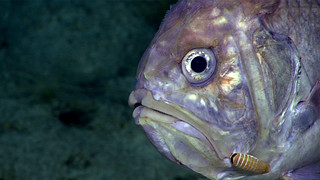Parasites are an enormous drain on all food production industries, costing aquaculture producers alone up to $6 billion USD per year. In recent years, there has been a shift away from chemical pesticides due to growing concerns over health and environmental effects, as well as parasites’ increasing resistance.
Most pests live short lives and have many offspring, leading to many opportunities for mutations that give them resistance to chemical pesticides, which explains why pesticides have decreased in effectiveness so quickly. This has spurred investigations into other ways to keep pests off of the food in the first place. Some farmers on land use natural compounds, such as carbon dioxide and pheromones, or light to lure pests such as moths, fruit flies, and mosquitos into traps.
Researchers at the James Cook University and Cawthorn Institute wanted to see whether the same principles could be applied to aquatic pests. There are many small parasites that attach to fish and feed on their skin, causing irritation and open wounds that can lead to illness. These pests can cause significant mortalities in fish farms, where the density of fish is higher than it would be in the wild, and therefore parasites can easily find a host. The researchers chose two parasites that are problematic for fish farmers and set up an experiment to see what common compounds could attract them. One parasite was a protozoan named Cryptocaryon irritans, and the other was a fluke named Neobenedenia girellae.
Based on past studies with different parasites, the researchers chose to present the parasites with the possible attractants of urea, fish mucus, or fellow parasites of the same species. Urea is excreted by fish through the gills and in urine, therefore higher concentrations in the water can indicate the presence of fish. To get mucus for this experiment, the researchers gently scraped some off of sedated barramundi. Barramundi are a common fish species that both parasites target and are grown in many farms around Australia. The researchers hypothesized that the parasites could follow the hosts’ excretions, the mucus or urea, to find them. Alternatively, the parasites could potentially seek out a group of parasites of the same species, which could indicate the direction of host animals.
The researchers put each potential attractant in a sealed container with seawater and connected each container to a central container, adding a fourth option of plain seawater as a control. They then put a specific number of newly hatched parasites into the central container and opened passages to the outer containers. After five minutes passed, they sealed the outer containers and added formalin, a chemical that instantly kills and preserves the parasites for analysis. Then they removed all the liquid and parasites together. They repeated this at least 8 times for each species of parasite, then counted and averaged the numbers of each parasite that chose each option.
They also tested whether the parasites preferred light or darkness. They set up two chambers attached to a central container, covered one chamber with black builder’s film, then set up a cold white LED light at the end of the other container. They again added parasites to the central container and allowed them five minutes to pick a chamber to go into, and repeated this at least eight times per species.
Of the four possible attractants, C. irritans was only noticeably attracted to the urea. C. irritans was also not influenced by light, meaning it chose the light or dark side in roughly equal amounts. N. girellae was only attracted to the LED light, none of the other potential attractants had significantly more individuals in them than the control.
The researchers also pinpointed when these parasites hatch to determine the best time to put out the traps. C. irritans hatched through the night, meaning the best time to put out traps for it would be sunset. N. girellae hatched right after sunrise, which makes sense given its attraction to light, meaning sunrise would be the best time to put out traps for them.
Learning as much as we can about the life cycles of parasites makes it easier to prevent them from ever latching on to the animals or plants we depend on for food and fibers. This can give farmers an environmentally friendly option that is also less stressful for animals. After determining what draws certain parasites in a specific direction, the next step is to design traps that are effective in real world scenarios. Sustainable farming has a long way to go, but research like this study is paving the way, one parasite at a time.


